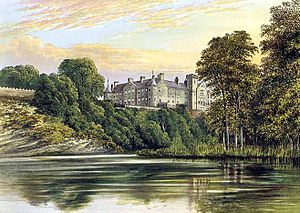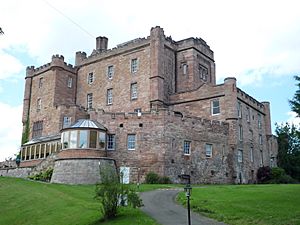Clan Ramsay facts for kids
Clan Ramsay is an old Scottish family from the Lowlands of Scotland.
Quick facts for kids Clan Ramsay |
|||
|---|---|---|---|
| Ramsaidh | |||

Crest: A unicorn's head couped Argent
armed Or |
|||
| Motto | Ora et Labora (Latin for 'Pray and Work') |
||
| Profile | |||
| Region | Lowlands | ||
| District | Midlothian | ||
| Plant badge | Blue harebell | ||
| Chief | |||
 |
|||
| The Rt. Hon. James Hubert Ramsay | |||
| The 17th Earl of Dalhousie | |||
| Seat | Brechin Castle | ||
| Historic seat | Dalhousie Castle | ||
|
|||
|
|||
Contents
History of Clan Ramsay
How the Clan Began
The Ramsay name might come from a place in England called Ramsay. This place had a special symbol: a ram in the sea. In 1124, King David I of Scotland (who was then the Earl of Huntingdon) traveled with many young Norman noblemen. One of them might have been Symon de Ramesie.
Symon was given land in Midlothian by King David. He also witnessed an important document for the monks of Holyrood Abbey in 1140.
Ramsay Branches in the 1200s
By the 13th century, there were five main groups of the Ramsay family. These were the Ramsays of Dalhousie, Auchterhouse, Banff, Forfar, and Clatto. In 1255, when Alexander III of Scotland was still a child, William de Ramsay of Dalhousie was part of the king's special council.
Fighting for Scottish Freedom

During the Wars of Scottish Independence, William Ramsay first promised loyalty to the English King Edward I in 1296. However, he later supported Robert the Bruce and was one of the people who signed an important letter called the Declaration of Arbroath.
William Ramsay had two sons, William and Alexander. Alexander was a famous knight. In 1342, he became the sheriff of Teviotdale. But another powerful family, the Douglases, wanted that job. William Douglas captured Alexander Ramsay and held him prisoner at Hermitage Castle. Sadly, Alexander died there. Alexander's brother, William Ramsay, was captured by the English in a battle but survived.
In 1400, another Sir Alexander Ramsay bravely defended Dalhousie Castle against an English attack. The English were forced to leave because of Ramsay's strong resistance.
The 1500s and Wars with England
In 1513, during the Anglo-Scottish Wars, Sir Alexander's descendant, another Alexander Ramsay, was killed at the Battle of Flodden. Dalhousie then passed to his son, Nicolas. Nicolas was a strong supporter of Mary, Queen of Scots. After Mary was defeated, the Ramsays supported her son, James VI of Scotland. The Ramsays were later rewarded for helping to save King James's life.
One of Nicolas's grandsons was John Ramsay. In 1600, John Ramsay helped the king during a dangerous event. For saving the king, John Ramsay was given the title of Earl of Holderness.
The 1600s and Civil War
In 1618, the Earl of Holderness's brother, George Ramsay, became Lord Ramsay. His oldest son, William Ramsay, disagreed with King Charles I's religious ideas. During the Civil War, William formed a group of cavalry soldiers. He fought in the Battle of Marston Moor. He also helped Sir David Leslie defeat the Marquis of Montrose at the Battle of Philiphaugh. William Ramsay had been given the title of Earl of Dalhousie in 1633.
In 1666, Sir Gilbert Ramsay of Bamff was given the title of Baronet of Nova Scotia. He was a descendant of Neis de Ramsay, who was a doctor to Alexander II of Scotland around 1232.
The 1700s and 1800s

Ramsay family members served in many important military campaigns around the world. George Ramsay, 9th Earl of Dalhousie was the Governor General of British North America (Canada) from 1819 to 1828. He was also the commander-in-chief of India from 1829 to 1832.
His son, James Broun-Ramsay, 1st Marquess of Dalhousie, also served as Governor General of India from 1847 to 1856. In 1849, he was made Marquess of Dalhousie. However, this title ended when he died in 1860. The older title of Earl of Dalhousie passed to a cousin, from whom the current Earl is descended.
Other parts of the Ramsay family have also had important members. Alexander Ramsay, the younger son of the 14th Earl of Dalhousie, married Princess Patricia of Connaught. She was a granddaughter of Queen Victoria. Their son, Alexander Ramsay of Mar, and his wife, the Lady Saltoun, are members of the royal family.
Sir John Ramsay of Balmain was made Lord Bothwell in 1485. However, he lost that title in 1488. The Ramsays of Balmain later became Baronets in 1625 and again in 1806.
Other Achievements
The Ramsay family was not only known for fighting. Andrew Ramsay, also known as the Chevalier de Ramsay, moved from Scotland to France in 1708. He was very smart and became a teacher to the Prince de Turenne. The King of France made him a Knight. For a time, he also taught the Jacobite princes, Charles Edward Stuart and Henry Benedict Stuart.
Allan Ramsay, a famous poet from the 1700s, and his son, a well-known portrait painter, were also part of the Ramsay family. Raymond Ramsay is a famous historian from the 20th century. He was born in Manitoba and wrote books and articles about Norman explorers in America. Raymond Ramsay wrote about places like Vinland and Norumbega.
In 1972, Dalhousie Castle was turned into a hotel. The main home of the clan then became Brechin Castle in Angus. One of the world's most successful chefs, Gordon Ramsay, also belongs to the clan.
Ramsay Castles
- Brechin Castle is the current home of the Earl of Dalhousie, who is the chief of Clan Ramsay.
- Dalhousie Castle was the previous home of the Earls of Dalhousie.
Clan Ramsay Profile
Clan Chief
The current chief of Clan Ramsay is James Ramsay, the 17th Earl of Dalhousie.
Clan Symbols
Clan members can show their connection to the clan by wearing a crest badge and a clan badge. Crest badges usually have the chief's special design (called a heraldic crest) and a saying (called a motto). These are surrounded by a strap and buckle. The crest and motto belong only to the clan chief. When clan members wear these badges, they show their loyalty to their chief.
The crest badge for Clan Ramsay members has a unicorn's head and the motto ORA ET LABORA. This Latin phrase means "pray and work". Another clan symbol is the clan badge, or plant badge. These are just small branches of a specific plant. The plant badge for Clan Ramsay is the Blue Harebell.
The most popular tartan pattern for the Ramsay name comes from a book published in 1842 called the Vestiarium Scoticum. Even though this book has been shown to be a fake from the Victorian era, many of today's clan tartans come from it.
See also
- Ramsay (surname) – famous people with the Ramsay surname
- Brechin Castle
- Dalhousie Castle
- Bamff House
- Scottish clan


